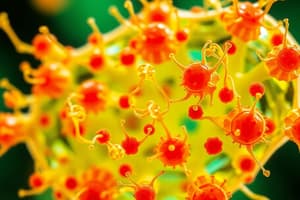Podcast
Questions and Answers
What is the primary reason that larger organisms contain more cells than smaller organisms?
What is the primary reason that larger organisms contain more cells than smaller organisms?
- Larger organisms have cells that are inherently larger.
- Larger organisms have a more complex structure.
- Larger organisms perform more metabolic processes.
- The number of cells is directly related to an organism's size. (correct)
Which type of organism is composed of a single cell?
Which type of organism is composed of a single cell?
- Humans
- Mosquitos
- Amoeba (correct)
- Roses
Which of the following statements about cell visibility is true?
Which of the following statements about cell visibility is true?
- Only specific large cells such as nerve cells can be viewed without magnification.
- All cells can be seen with the naked eye.
- Cells are generally too small to be seen without a microscope. (correct)
- Only unicellular organisms can be viewed with a microscope.
Why do red blood cells have a biconcave shape?
Why do red blood cells have a biconcave shape?
What is the largest type of cell in the human body?
What is the largest type of cell in the human body?
What is the primary function of the cell membrane?
What is the primary function of the cell membrane?
Which of the following organelles is NOT found in plant cells?
Which of the following organelles is NOT found in plant cells?
What component gives plant cells their rigidity?
What component gives plant cells their rigidity?
What is the role of nucleoplasm within the nucleus?
What is the role of nucleoplasm within the nucleus?
What type of cells contain chloroplasts?
What type of cells contain chloroplasts?
Which organelle is primarily responsible for energy production in cells?
Which organelle is primarily responsible for energy production in cells?
Which substance is primarily found in the cell wall of plant cells?
Which substance is primarily found in the cell wall of plant cells?
What is the liquid component of the cytoplasm referred to as?
What is the liquid component of the cytoplasm referred to as?
Flashcards
Cell structure
Cell structure
The fundamental building blocks of all living organisms, performing various functions.
Unicellular organisms
Unicellular organisms
Living things composed of a single cell.
Multicellular organisms
Multicellular organisms
Living things composed of many cells.
Cell size & organism size
Cell size & organism size
Signup and view all the flashcards
Cell's importance
Cell's importance
Signup and view all the flashcards
Cell Membrane
Cell Membrane
Signup and view all the flashcards
Cell Wall
Cell Wall
Signup and view all the flashcards
Cytoplasm
Cytoplasm
Signup and view all the flashcards
Nucleus
Nucleus
Signup and view all the flashcards
Mitochondria
Mitochondria
Signup and view all the flashcards
Chloroplasts
Chloroplasts
Signup and view all the flashcards
Vacuole
Vacuole
Signup and view all the flashcards
What is the difference between a plant cell and an animal cell?
What is the difference between a plant cell and an animal cell?
Signup and view all the flashcards
Study Notes
Cells - The Basic Unit of Life
- All living organisms are made of microscopic cells
- Cells are the basic structural and functional units of organisms
- All cells have similar chemical compositions and metabolic processes
- All cells come from pre-existing cells
Cell Types
- Unicellular organisms: consist of a single cell (e.g., Amoeba, Paramecium, bacteria, Chlamydomonas)
- Multicellular organisms: consist of millions or billions of cells (e.g., Volvox, rose, mosquito, mango, humans)
- Humans have approximately 200 different types of cells and 37.2 trillion cells in total
Cell Size
- Cells are generally very small and need a microscope to be seen
- Smallest cells: certain bacteria and some human cells (e.g., red blood cells)
- Largest cells: bird eggs (e.g., ostrich egg)
Cell Shapes
- Cell shapes are often related to their functions
- Example: human red blood cells are circular and biconcave for efficient oxygen transport in capillaries
Studying That Suits You
Use AI to generate personalized quizzes and flashcards to suit your learning preferences.




